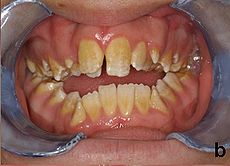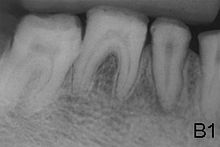- Amelogenesis imperfecta
-
Amelogenesis imperfecta Classification and external resources 
Amelogenesis imperfecta, hypoplastic type. Note the association of pitted enamel and open bite.ICD-10 K00.5 ICD-9 520.5 Amelogenesis imperfecta presents with abnormal formation of the enamel[1] or external layer of teeth. Enamel is composed mostly of mineral, that is formed and regulated by the proteins in it. Amelogenesis imperfecta is due to the malfunction of the proteins in the enamel: ameloblastin, enamelin, tuftelin and amelogenin.
People afflicted with amelogenesis imperfecta have teeth with abnormal color: yellow, brown or grey. The teeth have a higher risk for dental cavities and are hypersensitive to temperature changes. This disorder can afflict any number of teeth.
Contents
Genetics
Up to date, mutations in the AMELX, ENAM, MMP20, and KLK-4 genes have been found to cause amelogenesis imperfecta (non-syndromic form). The AMELX, ENAM, KLK-4 and MMP20 genes provide instructions for making proteins that are essential for normal tooth development. These proteins are involved in the formation of enamel, which is a hard, calcium-rich material that forms the protective outer layer of each tooth. Mutations in any of these genes alter the structure of these proteins or prevent the genes from making any protein at all. As a result, tooth enamel is abnormally thin or soft and may have a yellow or brown color. Teeth with defective enamel are weak and easily damaged.
Researchers are looking for mutations in other genes that may also cause amelogenesis imperfecta.
Types include:
Type OMIM Gene Locus AI1B 104500 ENAM 4q21 AI1C 204650 ENAM 4q21 AI2A1 603767 KLK4 19q13.4 AI2A2 612529 MMP20 11q22.3-q23 AI2A3 613211 WDR72 15q21.3 AI3 130900 FAM83H 8q24.3 AIH1 301200 AMELX Xp22.3-p22.1 Amelogenesis imperfecta can have different inheritance patterns depending on the gene that is altered. Most cases are caused by mutations in the ENAM gene and are inherited in an autosomal dominant pattern. This type of inheritance means one copy of the altered gene in each cell is sufficient to cause the disorder.
Amelogenesis imperfecta is also inherited in an autosomal recessive pattern; this form of the disorder can result from mutations in the ENAM or MMP20 gene. Autosomal recessive inheritance means two copies of the gene in each cell are altered.
About 5% of amelogenesis imperfecta cases are caused by mutations in the AMELX gene and are inherited in an X-linked pattern. A condition is considered X-linked if the mutated gene that causes the disorder is located on the X chromosome, one of the two sex chromosomes. In most cases, males with an X-linked form of this condition experience more severe dental abnormalities than affected females.
Other cases of this condition result from new gene mutations and occur in people with no history of the disorder in their family.
Treatment
Crowns are sometimes being used to compensate for the soft enamel.Usually stainless steel crowns are used in children which may be replaced by porcelain once they reach adulthood. In the worst case scenario, the teeth may have to be extracted and implants or dentures are required.
Epidemiology
The exact incidence of amelogenesis imperfecta is uncertain. Estimates vary widely, from 1 in 700 people in northern Sweden to 1 in 14,000 people in the United States.
References
- ^ Pieter J. Slootweg (2007). Dental pathology: a practical introduction. シュプリンガー・ジャパン株式会社. pp. 19–. ISBN 9783540716907. http://books.google.com/books?id=RZnrjMib-tQC&pg=PA19. Retrieved 28 December 2010.
- Winter GB, Brook AH (1975). "Enamel hypoplasia and anomalies of the enamel". Dent Clin North Am 19 (1): 3–24. PMID 162891.
- Simmer JP, Hu JC (2001). "Dental enamel formation and its impact on clinical dentistry". J Dent Educ 65 (9): 896–905. PMID 11569606.
- Aldred MJ, Savarirayan R, Crawford PJ (2003). "Amelogenesis imperfecta: a classification and catalogue for the 21st century". Oral Dis 9 (1): 19–23. doi:10.1034/j.1601-0825.2003.00843.x. PMID 12617253.
- Nusier M, Yassin O, Hart TC, Samimi A, Wright JT (2004). "Phenotypic diversity and revision of the nomenclature for autosomal recessive amelogenesis imperfecta". Oral Surg Oral Med Oral Pathol Oral Radiol Endod 97 (2): 220–30. doi:10.1016/j.tripleo.2003.08.007. PMID 14970781.
- Stephanopoulos G, Garefalaki ME, Lyroudia K (2005). "Genes and related proteins involved in amelogenesis imperfecta". J Dent Res 84 (12): 1117–26. doi:10.1177/154405910508401206. PMID 16304440.
Developmental tooth disease/tooth abnormality (K00–K01, 520) Quantity Abnormalities of
size and formConcrescence · Fusion · Gemination · Dens evaginatus/Talon cusp · Dens invaginatus · Enamel pearl · Macrodontia · Microdontia · Taurodontism · Supernumerary rootsDisturbances in
formationOther hereditary disturbances
in structureOther Categories:- Developmental tooth disorders
- Genetic disorders by system
Wikimedia Foundation. 2010.

